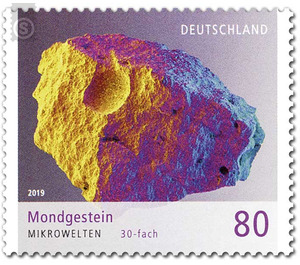Series "Microworlds" - Lunar rock - Germany / Federal Republic of Germany 2019 - 80 Euro Cent
Theme: Astronomy & Space
| Country | Germany / Federal Republic of Germany |
| Issue Date | 2019 |
| Face Value | 80.00 |
| Color | yellow violet |
| Printing Type | Multicolor offset printing |
| Stamp Type | Commemorative |
| Item Type | Stamp |
| SID | 838800 |
| Dimensions | 39.00 x 33.00 |
| In 27 Wishlists | |
Since time immemorial, the moon is by far the brightest object in the sky after the sun, and still exerts a special fascination on us to this day. Thanks to the manned moon landings between 1969 and 1972 as part of the US Apollo missions, we have come closer to the deciphering of the formation, construction and development of the Earth's moon. A total of 382 kilograms of lunar rock came to earth with the astronauts. The testing of the samples provided invaluable information. In addition to the Apollo missions, there were other ventures to recover lunar rocks. The then Soviet Union operated a busy space program and brought in the course of Luna missions between 1970 and 1976 using unmanned probes a total of 300 grams of lunar material to Earth. A third source is meteorites, which were broken by impacts from the lunar surface and catapulted over to us. In 30x magnification and iridescent colors, the lunar rock now also adorns the latest special postage stamp in the series "Microworlds".


